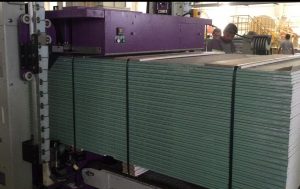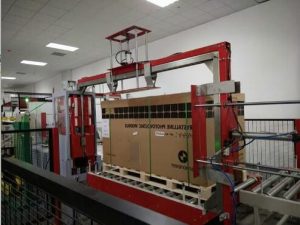Enhancing Warehouse Safety: The Role of Automatic Pallet Strapping Machines in Reducing Accident Rates
In demanding industrial environments, prioritizing worker safety while sustaining operational efficiency is critical. Implementing automatic pallet strapping machines presents a robust solution, streamlining packaging processes and significantly boosting workplace safety, thereby lowering accident rates. This article explores how these automated systems deliver tangible safety benefits and why they are increasingly vital for modern warehousing and logistics operations.
Understanding Automatic Pallet Strapping Machines
Automatic pallet strapping machines are engineered systems designed to secure goods onto pallets using plastic (typically PP or PET) or metal straps. They automate the strap feeding, tensioning, sealing, and cutting processes, ensuring load stability for transport and storage. Unlike manual or semi-automatic methods, fully automatic machines require minimal operator intervention, integrating seamlessly into conveyor lines and offering superior consistency, speed, and, critically, safety. Types vary, including vertical strapping for standard pallet loads and horizontal strapping for stabilizing layers or taller, unstable loads.
The High Stakes of Manual Strapping and Worker Safety
Worker safety is non-negotiable. Workplace accidents involving manual strapping can lead to serious injuries, resulting in lost workdays, increased workers' compensation costs, potential regulatory fines (e.g., from OSHA in the U.S.), and damage to employee morale. Manual strapping processes inherently carry risks including:
- Musculoskeletal Disorders (MSDs): Repetitive bending, twisting, and pulling associated with manual tensioning tools contribute significantly to back injuries and RSIs.
- Lacerations and Punctures: Handling sharp strap edges or using manual cutting tools increases the risk of cuts. Strap snap-back during tensioning or cutting can also cause severe injuries.
- Trip Hazards: Loose strapping material on the floor creates potential trip-and-fall hazards.
- Load Instability: Inconsistent manual tensioning can lead to improperly secured loads, posing risks during handling and transit.
Implementing proven safety technologies is essential for a productive, compliant, and safe work environment. (Consider linking to OSHA ergonomic guidelines or industry safety reports here)
How Automatic Strapping Machines Drive Safety Improvements
Automated systems directly address the hazards associated with manual methods.
1. Reducing Ergonomic Strain and Manual Exertion

The most significant safety advantage is the drastic reduction in manual labor and associated ergonomic risks. Automatic machines handle the physically demanding tasks of strap feeding, tensioning, and sealing. This eliminates awkward postures and repetitive motions known to cause MSDs, protecting workers from long-term strain and injury.
2. Minimizing Operator Error and Ensuring Load Security
Manual strapping effectiveness can vary based on operator technique, fatigue, or haste. Automatic machines deliver consistent strap placement and precise tensioning cycle after cycle. This uniformity is crucial for load integrity, reducing the chance of shifted or collapsed loads that can cause accidents within the facility or during shipment.
3. Preventing Direct Contact with Straps and Tooling
Automation removes the need for operators to directly handle strap edges or manual tensioning/cutting tools during the application process. This virtually eliminates the risk of cuts, pinches, and injuries from strap snap-back. Safety features like guarding and interlocks further protect operators during machine operation.
4. Enhancing Operational Awareness with Safety Features
Modern machines often incorporate advanced safety mechanisms such as:
- Light Curtains: Detect operator presence in hazardous zones, pausing operation.
- Emergency Stops: Easily accessible buttons to halt the machine instantly.
- Physical Guarding: Prevents accidental access to moving parts.
Boosting Operational Efficiency Alongside Safety
Safety improvements often go hand-in-hand with efficiency gains. Automatic strapping machines are significantly faster than manual methods, increasing throughput while ensuring dependable load containment.
Speed and Consistency
Automated systems offer unparalleled speed and consistency, strapping pallets uniformly in seconds. This predictable output helps streamline downstream processes and improves overall packaging line efficiency. Consistent load security also reduces the likelihood of product damage during handling and transit.
Reduced Operational Downtime
Fewer worker injuries mean less downtime associated with accident investigation, lost work hours, and personnel replacement. Furthermore, the reliability of automated systems compared to the variability of manual labor contributes to smoother, more predictable operations.
Achieving Cost Savings Through Automation and Safety
Investing in automatic strapping technology yields considerable economic advantages beyond direct labor savings.
Lower Insurance Premiums and Compensation Costs
A documented reduction in workplace injuries can lead to lower workers' compensation insurance premiums. Fewer accidents directly translate to decreased compensation claims and associated administrative burdens.
Optimized Material Usage
Automatic machines apply the precise amount of tension required and minimize strap waste compared to manual application, leading to savings on consumable materials.
Increased Productivity and Throughput
Faster cycle times and reduced downtime directly contribute to higher overall productivity, allowing facilities to handle greater volumes and improve profitability.
Seamless Integration into Production Lines
Contemporary automatic strapping machines are designed for easy integration with existing conveyor systems and packaging lines. PLC controls allow communication with other automated equipment and warehouse management systems (WMS).
Adaptability and Flexibility
These systems can typically handle a range of pallet sizes, load heights, and strapping patterns, offering flexibility for diverse operational needs. Setup and changeovers are often streamlined via user-friendly Human-Machine Interfaces (HMIs).
Operator Training and Maintenance
While intuitive, proper operator training on safe operation, clearing jams, and routine checks is crucial. Manufacturer support and clear documentation facilitate smooth implementation and ongoing maintenance, ensuring both safety and performance.

Leveraging Technological Advancements
Continuous innovation enhances the safety and performance of automatic strapping machines.
Smart Sensors and Controls
Advanced sensors detect pallet presence and positioning, ensuring straps are applied correctly and safely. Smart controls can automatically adjust tension based on load type, optimizing security while preventing product damage.
Remote Monitoring and Predictive Maintenance
Some systems offer remote monitoring capabilities, allowing supervisors to track performance and receive alerts. Predictive maintenance features use sensor data to anticipate potential failures, enabling proactive servicing to prevent unexpected downtime and associated hazards.
Environmental Considerations
Modern strapping systems also align with sustainability goals.
Compatibility with Eco-Friendly Strapping
Many machines are compatible with PET strapping, which often contains recycled content and is recyclable itself. Efficient material use also inherently reduces waste.
Energy Efficiency by Design
Manufacturers increasingly focus on energy efficiency, incorporating features like variable speed drives and automatic sleep modes to reduce power consumption during idle periods.
Real-World Impact: Observed Industry Benefits
(Note: Specific, verifiable data requires referencing actual case studies, often provided by equipment manufacturers or available in industry publications. The following illustrates typical outcomes.)
Companies across various sectors implementing automatic strapping systems consistently report significant improvements:
- Distribution Centers: Often see dramatic reductions (e.g., 30-50% or more) in manual handling injuries and a marked decrease in load failures during transit, improving delivery reliability.
- Manufacturing Plants: Report substantial increases in packaging line throughput (e.g., doubling the number of pallets strapped per hour) alongside measurable drops in ergonomic-related injury claims.
- Food and Beverage Industry: Benefit from consistent load security crucial for preventing product damage and meeting retailer requirements, while improving cold storage or sanitary environment operations where manual labor is challenging.
(Consider linking to relevant industry association reports or vendor case studies if available)
Conclusion: Investing in a Safer, More Efficient Future
Automatic pallet strapping machines represent a critical investment for operations prioritizing both worker safety and operational excellence. By automating demanding and potentially hazardous manual tasks, these systems directly reduce accident rates, particularly those related to ergonomic strain and improper load securing. The resulting benefits – enhanced safety, increased efficiency, consistent load integrity, and reduced operational costs – make automation a cornerstone of modern, competitive warehousing and logistics. Embracing this technology not only secures products effectively but, more importantly, safeguards the health and well-being of the workforce, fostering a safer and more productive operational environment.